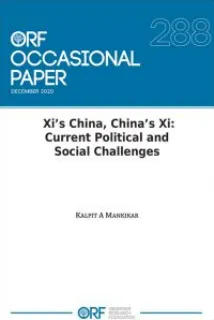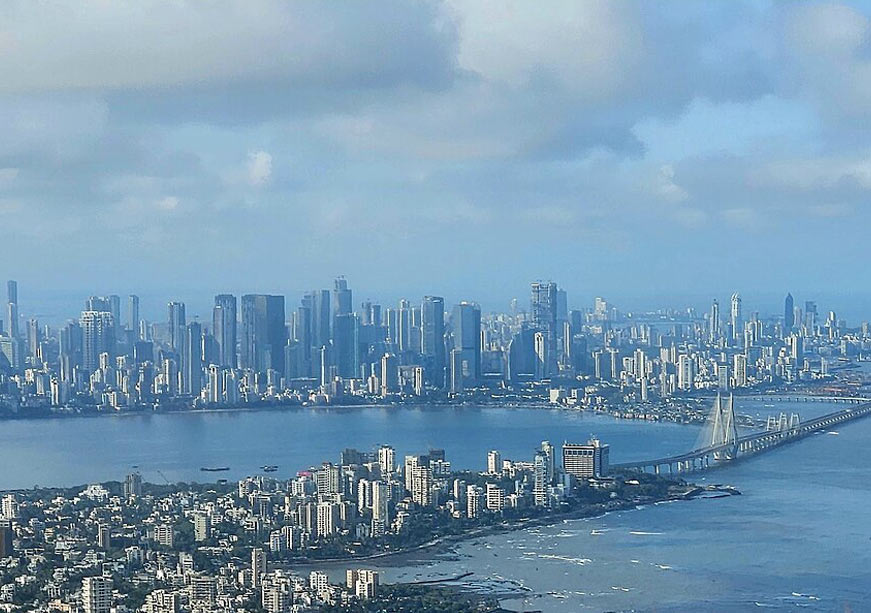The CCP faces a Catch-22: rapid economic development has bolstered its legitimacy but has come at the cost of the environment. The damage to habitats has also been compounded by feeble attempts at enforcing legislation as the promotion of provincial leaders depends on the region’s economic performance. Land degradation that forces migration and displacement of its citizens is also a key challenge for the CCP.
The CCP draws its authority from ensuring economic growth, but that prosperity has created vast disparities. The pandemic has stoked fears of worsening conditions for China’s underprivileged. Changes to the hukou household registry system are also creating a new divide among the rich and educated on the one hand, and rural migrants and the poor on the other. This may be a faultline in the future as such zoning rules could lead to exclusive enclaves for the rich and poor.
The passage of the civil code would make it seem that China is moving towards the ‘rule of law’. Efforts are on to establish a more robust legal system for enterprises to make China more “predictable”. But this appears to be more of an exercise to create the perception of an independent judiciary in non-political matters. The CCP will continue to ignore the law when it wants to.
Political reform, the aspirations of the poor and minorities, and environmental protection are the building blocks of China’s future. How Xi proceeds on these will be key to China’s stability and development.
About the Author
Kalpit A Mankikar is a Fellow with ORF’s Strategic Studies Programme.
Endnotes
[a] China regards its students as a form of soft power.
[1] Kerry Brown, CEO, China (I.B Tauris & Co, 2016), pp. 54-55.
[2] Brown, CEO, China, pp. 213.
[3] Cai Xia, “一个体制内人士与北京决裂,” (An insider parts ways with Beijing), Foreign Affairs, December 4, 2020.
[4] Xi Jinping, The Governance of China, (Foreign Languages Press, 2018), pp. 61.
[5] Jinping, The Governance of China
[6] “China’s efforts to boost Mandarin-use in schools angers ethnic Mongols,” The Economist, September 5, 2020.
[7] People’s Government of Tibet Autonomous Region, Government of People’s Republic of China.
[8] “张峰: 习近平中央统战工作会议重要讲话的8个创新性亮点” (Highlights of Xi Jinping’s speech at Central United Front Work Conference), People’s Daily, June 6, 2015.
[9] The State Council, Government of People’s Republic of China.
[10] “China makes historic progress over 13th Five-Year Plan period under Xi’s leadership,” People’s Daily, October 26, 2020.
[11] “China to ease urban residency restrictions to boost urbanization,” People’s Daily, April 10, 2020.
[12] “Xi stresses significance of Civil Code, better protecting people’s legitimate rights, interests,” Xinhua, May 29, 2020.
[13] Venus Wu & Julie Zhu, “Missing China billionaire taken from Hong Kong hotel in wheelchair: source,” Reuters, February 11, 2017.
[14] Jinping, The Governance of China , pp. 38.
[15] Ma Jingshun,习近平的内部讲话 (The Internal Talks of Xi Jinping), (Hong Kong: Guangdu Shuju Publishing, 2014), pp. 52.
[16] John Fairbank, The Chinese World Order, (Cambridge: Harvard University Press, 1968), pp. 3.
[17] Wu Gang and Liu Linlin, “Xi vows to boost rule of law,” Global Times, December 5, 2012.
[18] Jinping, The Governance of China , pp. 29.
[19] Jingshun, The Internal Talks of Xi Jinping, pp. 52.
[20] Jinping, The Governance of China, pp. 102-103.
[21] Timothy R. Heath, China’s New Governing Party Paradigm: Political Renewal and the Pursuit of National Rejuvenation, (Routledge, 2014), pp. 3-5.
[22] Jinping, The Governance of China, pp. 15.
[23] Jinping, The Governance of China, pp. 18.
[24] “China consolidates sweeping victory against corruption in 2019,” People’s Daily, December 31, 2019.
[25] “China consolidates sweeping victory against corruption in 2019”
[26] Leon Aron, “Everything You Think You Know About the Collapse of the Soviet Union Is Wrong,” Foreign Policy, June 20, 2011.
[27] Xi Jinping, (习近平关于防范风险挑战、应对突发事件论述摘编》出版发行–时政–人民网), (Thoughts on Preventing Risks, Challenges and Responding to Emergencies), (Central Literature Publishing House, 2020), pp. 38.
[28] “The red front-line,” The Economist, September 12, 2020.
[29] “Xi stresses CPC leadership of state-owned enterprises,” China Daily, October, 12, 2016.
[30] Clive Hamilton and Mareike Ohlberg, Hidden Hand: Exposing How the Chinese Communist Party Is Reshaping the World (E-book), (Oneworld Publications, 2020), chap. 6.
[31] Wang Jiamei and Huang Ge, “SOEs to unify Party, board chairman posts,” Global Times, December 18, 2016.
[32] Joshua Philipp, “What’s Going On With Xi?; Big Explosion Covered Up by Chinese State Media,” YouTube video, 25.06 min, September 11, 2020.
[33] Jinping, Thoughts on Preventing Risks, Challenges and Responding to Emergencies, pp. 230.
[34] “What happened to the Central Party School expelling retired teacher Cai Xia,” Qianlong.com, August 18, 2020.
[35] Ananth Krishnan, India’s China Challenge (E-Book), (HarperCollins India, 2020), chap 2.
[36] Jinping, The Governance of China, pp. 37-38.
[37] M. Taylor Fravel, Strong Borders, Secure Nation: Cooperation and Conflict in China’s Territorial Disputes (E-Book), (Princeton University Press, 2008), chap. 1.
[38] Edward Friedman, “Reconstructing China’s National Identity: A Southern Alternative to Mao-Era Anti-Imperialist Nationalism,” The Journal of Asian Studies 53, no. 1 (1994).
[39] Toward A Second Generation of Ethnic Policies?, ed. James Leibold, in The Jamestown Foundation. The Jamestown Foundation. https://jamestown.org.
[40] Hu Angang and Lianhe Hu, “第二代民族政策,” (Second Generation Minzu Policies), Xinjiang Normal University Journal, 32 (2011): 1–13.
[41] State Department, Government of United States of America.
[42] “China’s efforts to boost Mandarin-use in schools angers ethnic Mongols”
[43] “Language teaching policy scientific and progressive,” People’s Daily, September 22, 2020.
[44] Edward Wong, “China Charges Tibetan Education Advocate With Inciting Separatism,” New York Times, March 31, 2016.
[45] People’s Government of Tibet Autonomous Region, Government of People’s Republic of China.
[46] Ma Rong, “二十一世纪的中国是否存在国家分裂的风险,” (Is There a Risk That China Could Split in the 21st Century?), Lingdaozhe (2011): 38-39.
[47] “Report at 19th CPC National Congress,” Xinhua, October 18, 2017.
[48] Realise the Four Modernations and Never Seek Hegemony, Deng Xiaoping, in the Selected Works of Deng Xiaoping. Selected Works of Deng Xiaoping.
[49] Jinping, Thoughts on Preventing Risks, Challenges and Responding to Emergencies, pp. 48.
[50] Ministry of Education, Government of the People’s Republic of China.
[51] Ministry of Education, Government of the People’s Republic of China.
[52] 我們當下的恐懼與期待 (Imminent Fears, Immediate Hopes), ed. Xu Zhangrun, in the Unirule Institute of Economics. Unirule Institute of Economics. http://english.unirule.cloud.
[53] Academic Freedom in Hong Kong since 2015: Between two systems, ed. Kevin Carrico, in the Hong Kong Watch. Hong Kong Watch.
[54] Michelle Chan, Cheng Ting-Fang, and Lauly Li, “Hong Kong security law spurs fears over academic freedom,” Nikkei Asia, September 10, 2020.
[55]“张峰: 习近平中央统战工作会议重要讲话的8个创新性亮点” (Highlights of Xi Jinping’s speech at Central United Front Work Conference)
[56] Clive Hamilton, Silent Invasion, (Hardie Grant, 2018), chap. 8, chap. 10.
[57] Australia, Parliament of Australia, Submission to the Parliamentary Joint Committee on Intelligence and Security, (Canberra: Parliament of Australia, 2017).
[58] Justice Department, Government of the United States of America.
[59] “Australia to tackle foreign interference at universities,” BBC, August 28, 2019.
[60] “US cancels over 1,000 visas for Chinese deemed security risks,” Nikkei Asia, September 10, 2020.
[61] Lucy Fisher, “Chinese students face ban amid security fears,” The Times, October 1, 2020.
[62] Yifan Yu, “US to suspend entry of Chinese students with military ties,” Nikkei Asia, May 30, 2020,
https://asia.nikkei.com/Business/Education/US-to-suspend-entry-of-Chinese-students-with-military-ties.
[63] Branwen Jeffreys, “UK universities see boom in Chinese students,” BBC, January 21, 2020, https://www.bbc.com/news/education-51149445.
[64] “Xi calls for enhancing biodiversity conservation, global environmental governance,” People’s Daily, September 30, 2020, http://en.people.cn/n3/2020/0930/c90000-9766274.html
[65] World Economic Forum, Chart of the day: These countries create most of the world’s CO2 emissions, ed. Sean Fleming, in the World Economic Forum, https://www.weforum.org/agenda/2019/06/chart-of-the-day-these-countries-create-most-of-the-world-s-co2-emissions/. World Economic Forum. https://www.weforum.org.
[66] Elizabeth C. Economy, The River Runs Black (Cornell University Press, 2004), pp. 54.
[67] Frank Dikotter, Mao’s Great Famine (Bloomsbury, 2010), pp. 184-185.
[68] Environmental Management in China, ed. Qu Geping and Li Jinchan, in the Food and Agricultural Organisation, http://www.fao.org/docrep/p4150e/p4150e01.htm. Food and Agricultural Organisation. http://www.fao.org.
[69] Elizabeth C. Economy, The Third Revolution: Xi Jinping and the New Chinese State (E-Book), (Oxford University Press, 2018), chap. 6.
[70] Economy, The Third Revolution: Xi Jinping and the New Chinese State, chap. 6.
[71] Yifang Chen, “Land of 1,000 Landfills,” Slate, June 29, 2015, http://www.slate.com/articles/life/caixin/2015/06/unregulated_landfill_epidemic_china_s_capital_is_cleaning_up_more_than_1.html.
[72] “How much is pollution costing China’s economy?,” Deutsche Welle, March 18, 2015, https://www.dw.com/en/how-much-is-pollution-costing-chinas-economy/a-18323476
[73] Air Pollution Overview, in the Berkeley Earth database, http://berkeleyearth.org/air-pollution-overview/. Berkeley Earth. http://berkeleyearth.org.
[74] Economy, The Third Revolution: Xi Jinping and the New Chinese State, chap. 6.
[75] “No Quick Fix for Contaminated Rice in China,” Wall Street Journal, May 21, 2013,
https://www.wsj.com/articles/BL-CJB-17739
[76] Kakali Mukhopadhyay et al., “Food security in China at 2050: a global CGE exercise,” Journal of Economic Structures, no. 7 (2018), https://doi.org/10.1186/s40008-017-0097-4.
[77] “China’s pork prices retreat last week,” Xinhua, February 25, 2020, http://www.xinhuanet.com/homas/2020-02/25/c_138816911.htm
[78] Wang Qi, “China launches Clean Plate Campaign 2.0 as Xi calls for end to food wastage,” Global Times, August 13, 2020, https://www.globaltimes.cn/content/1197577.shtml.
[79] The State Council, Chinese Government, http://english.www.gov.cn/policies/latestreleases/202009/15/content_WS5f60c43cc6d0f7257693c077.html
[80] Edward Wong, “Resettling China’s ‘Ecological Migrants’,” New York Times, October 25, 2016,
https://www.nytimes.com/interactive/2016/10/25/world/asia/china-climate-change-resettlement.html.
[81] Linda Lew, “After coronavirus, flooding hits southern China with 14 million affected,” South China Morning Post, June 27, 2020, https://www.scmp.com/news/china/society/article/3090854/after-coronavirus-flooding-hits-southern-china-14-million.
[82] Yuming Guo,“Floods in China, COVID-19, and climate change,” The Lancet (2020), https://doi.org/10.1016/S2542-5196(20)30203-5.
[83] Zamir Ahmed Awan, “China’s victory against poverty appreciated,” People’s Daily, September 23, 2020, http://en.people.cn/n3/2020/0923/c90000-9763586.html.
[84] James Parker, “Inharmonious Society? China’s Rising Income Inequality,” The Diplomat, December 15, 2012, https://thediplomat.com/2012/12/inharmonious-society-chinas-rising-income-inequality/.
[85] Anthony Shorrocks and Rodrigo Lluberas, The Global Wealth Report 2019, European Union, Credit Suisse, 2019, https://www.credit-suisse.com/about-us/en/reports-research/global-wealth-report.html
[86] “The Global Wealth Report 2019”
[87] Helen Davidson, “Thomas Piketty refuses to censor latest book for sale in China,” The Guardian, August 31, 2020, https://www.theguardian.com/books/2020/aug/31/homas-piketty-refuses-to-censor-latest-book-for-sale-in-china.
[88] Kent Deng, Mapping China’s Growth and Development in the Long Run (E-Book), (Imperial College Press, 2015), chap. 7.
[89] “What is China’s ‘Two Sessions’ and why is it so globally important?,” CGTN, May 22, 2020,
https://newseu.cgtn.com/news/2020-05-22/What-is-China-s-Two-Sessions-and-why-is-it-so-globally-important–QELA9GDCN2/index.html
[90] Sidney Leng, “China confirms more than 40 per cent of population survived on just US$141 per month in 2019,” South China Morning Post, June 15 2020, https://www.scmp.com/economy/china-economy/article/3089128/china-confirms-more-40-cent-population-survived-just-us141.
[91] World Bank, From Containment to Recovery, October 2020, Washington DC, World Bank Group, 2020, https://www.worldbank.org/en/region/eap/overview
[92] National Bureau of Statistics, Government of the People’s Republic of China, http://www.stats.gov.cn/english/PressRelease/202010/t20201021_1795384.html
[93] Sidney Leng, “China’s income inequality could expand in 2020 as outbreak rattles world’s No 2 economy,” South China Morning Post, March 17, 2020,
https://www.scmp.com/economy/china-economy/article/3075497/coronavirus-chinas-income-inequality-could-expand-2020.
[94] Leng, “China’s income inequality could expand in 2020 as outbreak rattles world’s No 2 economy”
[95] “External risks, but China’s economy still resilient: Xi,” The Hindu, September 19, 2020, https://www.thehindu.com/business/Economy/external-risks-but-chinas-economy-still-resilient-xi/article32650652.ece
[96] “US-China investment falls to lowest in 9 years amid tensions,” Nikkei Asia, September 17, 2020, https://asia.nikkei.com/Politics/International-relations/US-China-tensions/US-China-investment-falls-to-lowest-in-9-years-amid-tensions
[97] Tetsushi Takahashi, “Chinese tourists flock to Communist Party ‘holy sites’,” Nikkei Asia, September 22, 2020, https://asia.nikkei.com/Business/Travel-Leisure/Chinese-tourists-flock-to-Communist-Party-holy-sites.
[98] “Red tourism booms in China,” Xinhua, March 9, 2019, http://www.xinhuanet.com/english/2019-03/09/c_137881288.htm
[99] “China makes historic progress over 13th Five-Year Plan period under Xi’s leadership,” People’s Daily, October 26, 2020, http://en.people.cn/n3/2020/1026/c90000-9772749.html
[100] Dexter Roberts, The Myth of Chinese Capitalism, (Macmillan, 2020), pp. 188-189.
[101] Jinping, Thoughts on Preventing Risks, Challenges and Responding to Emergencies, pp 91-92.
[102] Peter Farrar, “China’s New Generation of Urban Migrants,” The Diplomat, June 29, 2016, https://thediplomat.com/2016/06/chinas-new-generation-of-urban-migrants/.
[103] “China to bring vagrants and beggars into social security system,” People’s Daily, May 9, 2020,
http://en.people.cn/n3/2020/0509/c90000-9688370.html
[104] “China to ease urban residency restrictions to boost urbanization,” People’s Daily, April 10, 2020,
http://en.people.cn/n3/2020/0410/c90000-9678118.html
[105] “习近平在亚太经合组织工商领导人对话会上的主旨演讲,” (Keynote address to APEC business leaders by Xi), Xinhua, November 19, 2020, http://www.xinhuanet.com/politics/leaders/2020-11/19/c_1126759154.htm
[106] Yan Yunxiang, “China Briefing 2000: the continuing transformation,” Tyrene White, ed (Armonk NY: M E Sharpe, 2000)
[107] “Xi stresses significance of Civil Code, better protecting people’s legitimate rights, interests,” Xinhua, May 29, 2020, http://www.xinhuanet.com/english/2020-05/29/c_139099230.htm
[108] “王利明: 民法典将为实现人民群众美好幸福生活提供重要保障,” (Wang Liming: Civil Code to offer important guarantee for the people), Xinhua, May 21, 2020, http://www.xinhuanet.com/legal/2020-05/21/c_1210628099.htm
[109] “China adopts milestone Civil Code,” Xinhua, May 29, 2020, http://en.people.cn/n3/2020/0529/c90000-9695738.html
[110] “Maintain and promote justice,” People’s Daily, November 23, 2020,
(http://paper.people.com.cn/rmrb/html/2020-11/23/nw.D110000renmrb_20201123_5-01.htm)
[111] Fu Ying, “Cooperative Competition Is Possible Between China and the U.S.,” New York Times, November 24, 2020, https://www.nytimes.com/2020/11/24/opinion/china-us-biden.html.
[112] Venus Wu and Julie Zhu, “Missing China billionaire taken from Hong Kong hotel in wheelchair: source,” Reuters, February 11, 2017, https://www.reuters.com/article/us-china-hongkong-billionaire-idUSKBN15Q09Q.
[113] Chinese Banking and Insurance Regulatory Commission press statement, Government of the People’s Republic of China,
https://www.cbirc.gov.cn/cn/view/pages/ItemDetail.html?docId=917198&itemId=915
[114] China Securities Regulatory Commission press statement, Government of People’s Republic of China,
http://www.csrc.gov.cn/pub/newsite/zjhxwfb/xwdd/202007/t20200717_380266.html
[115] Minxin Pei, “The four albatrosses weighing down Xi Jinping,” Asia Nikkei, October 7, 2020,
https://asia.nikkei.com/Opinion/The-four-albatrosses-weighing-down-Xi-Jinping.
[116] Shubhajit Roy, “Quad meet: Eye on China, India seeks ‘respect for territorial integrity’,” Indian Express, October 7, 2020, https://indianexpress.com/article/india/quad-meet-eye-on-china-india-seeks-respect-for-territorial-integrity-6705881/.
[117] Ankit Panda, “Is the Time Right for Japan to Become Five Eyes’ ‘Sixth Eye?,” The Diplomat, August 15, 2020, https://thediplomat.com/2020/08/is-the-time-right-for-japan-to-become-five-eyes-sixth-eye/.
[118] “U.S. Navy carrier conducted exercises in South China Sea on Aug. 14,” Reuters, August 15, 2020, https://www.reuters.com/article/us-southchinasea-usa-defence-idUSKCN25B065
[119] Department of Health & Human Service, Government of the United States of America, https://www.hhs.gov/about/news/2020/08/04/hhs-secretary-alex-azar-lead-delegation-taiwan-in-first-visit-by-us-hhs-secretary.html
[120] “US approves $1.8bn weapons sale to Taiwan,” BBC, October 22, 2020, https://www.bbc.com/news/world-asia-54641076
[121] Keoni Everington, “John Bolton calls on US to give diplomatic recognition to Taiwan,” Taiwan News, April 16, 2020, https://www.taiwannews.com.tw/en/news/3917236.
[122] “Japan, Vietnam agree to boost defence ties in face of China’s expanding influence,” Economic Times, October 19, 2020,
https://economictimes.indiatimes.com/news/defence/japan-vietnam-agree-to-boost-defence-ties-in-face-of-chinas-expanding-influence/articleshow/78745999.cms?from=mdrß
[123] “Xi Jinping urges keeping Chinese spirit shown in War to Resist U.S. Aggression and Aid Korea alive,” CGTN, October 20, 2020, https://news.cgtn.com/news/2020-10-19/Exhibition-held-to-mark-War-to-Resist-U-S-Aggression-and-Aid-Korea-UIGSUhyitO/index.html

 PDF Download
PDF Download



 PREV
PREV

